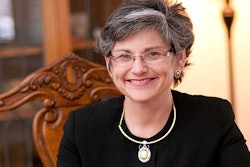CRYSTAL LAKE, Ill. — Leticia Castanon concentrated on the difference between the words “must” and “should” scribbled on a white board in a McHenry County College classroom.
If she wants to master the English language, she should study, the 45-year-old wife and mother thought.
And if she wants to get a job that pays better than her current gig in fast food, Castanon, a Mexican immigrant, told herself she must learn English.
“I need it to better understand people,” Castanon said. “I started five or six years ago learning English.”
There are four people in Castanon’s English as a Second Language course at McHenry County College, and more than 540 in all ESL classes college-wide, school enrollment data shows.
Just shy of 87 percent of students enrolled in ESL classes are Hispanic. These students are among a growing group of Hispanics trudging through the nuances of the English language.
A recent study from the Pew Research Center shows a record 32 million Hispanics living in the United States speak English proficiently. http://www.pewhispanic.org/2015/05/12/english-proficiency-on-the-rise-among-latinos/
English-speaking Hispanics accounted for 68 percent of the Hispanic population in 2013, the study showed, up from 59 percent in 2000.
The study attributes the increase to the number of U.S.-born Hispanics, a growing segment of the Hispanic population.
In 2013, there were nearly twice as many U.S.-born Hispanics as there were foreign-born, 35 million to 19 million, respectively. U.S.-born Hispanics also have a median age of half that of foreign-born Hispanics.
Castanon is a living example of that statistic. Immigrating from Mexico in 2002, she lives in Woodstock with her husband and her son, Alan, 12.
They speak Spanish at home, but Castanon said she also sometimes gets informal English lessons from her son.
“He’s up there,” she said. “He is my teacher.”
The reasons for non-native English speakers to learn the language include finding a job or earning their high school equivalence, said Tom Pierce, executive director of adult education at McHenry County College. Learning English often is the first or second step, he said.
“If they’re interested at all, we try to find them a pathway,” Pierce said. “We know when they finish our program, they’re probably not ready for college, and they might not be ready for a job that can provide them a family-providing wage.”
According to the Pew study, 75 percent of Hispanics who do not speak English at all have less than a high school education, compared with 18 percent of Hispanics who speak English very well.
Virgilio Zelaya, who immigrated from Honduras eight years ago, understands why educational attainment might be more difficult for non-English speakers. Zelaya, 34, said he had zero knowledge of the English language when he moved to the U.S.
“You pretend you know everything, but it’s hard, really hard,” Zelaya said. “It was hard. Nobody understood me. I remember one day I went to the store and somebody wanted to talk to me, and I just ran away because I was so scared.”
Zelaya took English and GED classes at MCC during the day while working at a bar at night. After earning his GED and completing ESL classes, he finished a certificate in manufacturing design technologies in December. He’s taken some college classes and plans to earn an associate degree.
He still practices his English. He watches movies in English he knows in Spanish, and reads books in the same way. Now, Zelaya doesn’t avoid the grocery store for fear of having to speak to someone. In fact, he’s an assistant manager in the produce section at Joseph’s Marketplace in Crystal Lake.
“My English is not perfect,” Zelaya said. “But I can speak. I can have communication. I can be a social person. I feel good about it.”


















